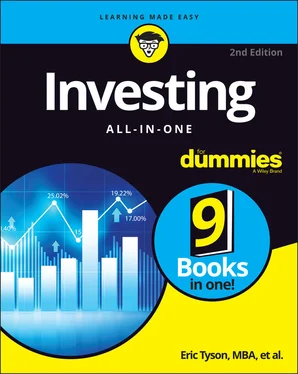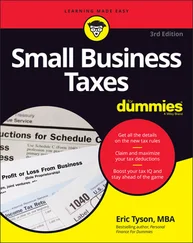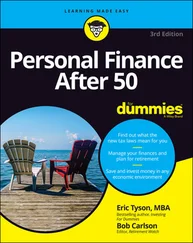Eric Tyson - Investing All-in-One For Dummies
Здесь есть возможность читать онлайн «Eric Tyson - Investing All-in-One For Dummies» — ознакомительный отрывок электронной книги совершенно бесплатно, а после прочтения отрывка купить полную версию. В некоторых случаях можно слушать аудио, скачать через торрент в формате fb2 и присутствует краткое содержание. Жанр: unrecognised, на английском языке. Описание произведения, (предисловие) а так же отзывы посетителей доступны на портале библиотеки ЛибКат.
- Название:Investing All-in-One For Dummies
- Автор:
- Жанр:
- Год:неизвестен
- ISBN:нет данных
- Рейтинг книги:3 / 5. Голосов: 1
-
Избранное:Добавить в избранное
- Отзывы:
-
Ваша оценка:
- 60
- 1
- 2
- 3
- 4
- 5
Investing All-in-One For Dummies: краткое содержание, описание и аннотация
Предлагаем к чтению аннотацию, описание, краткое содержание или предисловие (зависит от того, что написал сам автор книги «Investing All-in-One For Dummies»). Если вы не нашли необходимую информацию о книге — напишите в комментариях, мы постараемся отыскать её.
Investing All-in-One For Dummies
.
Dummies
Investing All-in-One For Dummies
Investing All-in-One For Dummies
Investing All-in-One For Dummies — читать онлайн ознакомительный отрывок
Ниже представлен текст книги, разбитый по страницам. Система сохранения места последней прочитанной страницы, позволяет с удобством читать онлайн бесплатно книгу «Investing All-in-One For Dummies», без необходимости каждый раз заново искать на чём Вы остановились. Поставьте закладку, и сможете в любой момент перейти на страницу, на которой закончили чтение.
Интервал:
Закладка:
For example, if you have outstanding credit card debt at 18 percent interest, paying off that debt is the same as putting your money to work in an investment with a guaranteed 18 percent tax-free annual return. Because the interest on consumer debt isn’t tax-deductible, you would need to earn more than 18 percent by investing your money elsewhere to net 18 percent after paying taxes. Earning such high investing returns is highly unlikely, and to earn those returns, you’d be forced to take great risk.
 Consumer debt is hazardous to your long-term financial health (not to mention damaging to your credit score and future ability to borrow for a home or general ability to save and invest) because it encourages you to borrow against your future earnings. People say such things as “I can’t afford to buy a new car for cash, given how expensive new cars are.” Well, okay. New cars are expensive, so you need to set your sights lower and buy a good used car that you can afford. You can then invest the money that you’d otherwise spend on your auto loan.
Consumer debt is hazardous to your long-term financial health (not to mention damaging to your credit score and future ability to borrow for a home or general ability to save and invest) because it encourages you to borrow against your future earnings. People say such things as “I can’t afford to buy a new car for cash, given how expensive new cars are.” Well, okay. New cars are expensive, so you need to set your sights lower and buy a good used car that you can afford. You can then invest the money that you’d otherwise spend on your auto loan.
Establishing an emergency reserve
You never know what life will bring, so having an accessible reserve of cash to meet unexpected expenses makes good financial sense. If you have generous parents or dear relatives, you can certainly consider using them as your emergency reserve. Just be sure you ask them in advance how they feel about that before you count on receiving funding from them. If you don’t have a financially flush family member, the onus is on you to establish a reserve.
 You should have at least three months’ worth of living expenses to as much as 12 months’ worth of living expenses as an emergency reserve (see Chapter 1in Book 2). Invest this personal-safety-net money in a money market fund (see Chapter 4in Book 2). You may also be able to borrow against your employer-based retirement account or against your home’s equity, should you find yourself in a bind, but these options are much less desirable.
You should have at least three months’ worth of living expenses to as much as 12 months’ worth of living expenses as an emergency reserve (see Chapter 1in Book 2). Invest this personal-safety-net money in a money market fund (see Chapter 4in Book 2). You may also be able to borrow against your employer-based retirement account or against your home’s equity, should you find yourself in a bind, but these options are much less desirable.
If you don’t have a financial safety net, you may be forced, under duress, to sell an investment (at a relatively low price) that you’ve worked hard for. And selling some investments, such as real estate, can take time and cost significant money (transaction costs, taxes, and so on).
 Riskier investments like stocks aren’t a suitable place to keep your emergency money invested. While stocks historically have returned about 9 percent per year, about one-third of the time, stocks decline in value in a given year, sometimes substantially. Stocks can drop and have dropped 20, 30, or 50 percent or more over relatively short periods of time. Suppose that such a decline coincides with an emergency, such as the loss of your job or a health problem that creates major medical bills. During the 2020 government-mandated economic shutdowns due to the COVID-19 pandemic, remember how (U.S. and most international) stocks dropped more than 30 percent in just a few weeks while millions of people lost their jobs? Your situation may force you to sell at a loss, perhaps a substantial one. Stocks are intended to be a longer-term investment, not an investment that you expect (or need) to sell in the near future.
Riskier investments like stocks aren’t a suitable place to keep your emergency money invested. While stocks historically have returned about 9 percent per year, about one-third of the time, stocks decline in value in a given year, sometimes substantially. Stocks can drop and have dropped 20, 30, or 50 percent or more over relatively short periods of time. Suppose that such a decline coincides with an emergency, such as the loss of your job or a health problem that creates major medical bills. During the 2020 government-mandated economic shutdowns due to the COVID-19 pandemic, remember how (U.S. and most international) stocks dropped more than 30 percent in just a few weeks while millions of people lost their jobs? Your situation may force you to sell at a loss, perhaps a substantial one. Stocks are intended to be a longer-term investment, not an investment that you expect (or need) to sell in the near future.
What about Paying Down Other Debts?
Getting out from under 18 percent interest rate credit card debt is clearly a priority and a bit of a no-brainer. But what should you do about other debts that carry a more reasonable interest rate? This section talks you through some common examples: student loans and mortgage debt.
Assessing student loans
If you’re one of many young adults with lingering student loan debt, you’re probably wondering whether you should focus your efforts on paying down that debt or instead invest the extra cash you have.
The best choice hinges on the interest rate on this debt (after factoring in any tax breaks) and how that compares with the expected return from investing. Of course, you must be reasonable and not pie-in-the-sky about the rate of return you expect from your investments.
Under current tax laws, with student loans, you can deduct up to $2,500 in student loan interest annually on your federal 1040 income tax return. So this deduction can lower the effective interest rate you’re paying on your student loans. This deduction is available to single taxpayers with adjusted gross incomes (before subtracting the student loan interest) of $70,000 or less and married couples filing jointly with such incomes of $140,000 or less. Partial deductions are allowed for incomes up to $85,000 for singles and $170,000 for married couples filing jointly. Another requirement for taking this deduction is that you and your spouse, if filing jointly, cannot be claimed as dependents on someone else’s income tax return.
If you can deduct student loan interest on your tax return, to determine the value of that deduction, see Chapter 2in Book 2 to understand what tax bracket you’re in (what your marginal tax rate is). For most moderate income earners, 25 percent is a reasonable number to work with.
Suppose you have student loans outstanding at the attractive interest rate of just 3.5 percent. Assume that you’re able to deduct all this interest and that your income tax bracket is 25 percent. So, after taxes, the effective interest rate on your student loan is 3.5 percent – (0.25 × 3.5 percent) = 2.63 percent.
Now, the question to consider is this: Can you reasonably expect to earn an average annual rate of return from your investments of more than this 2.63 percent? If you invest your money in a sleepy bank account, the answer will surely be no. If you instead invest in things like stocks and bonds, over the long term, you should come out with a higher return.
If you have student loans at a higher interest rate — say, 6 percent — it may make more sense to pay those loans down faster with your extra cash than to invest that money elsewhere. To get a higher return than that from investments, you need to take a fair amount of risk, and of course there’s no guarantee that you’ll actually make a high enough return to make it worth your while.
When deciding whether you should pay down student loans faster, there are some factors to consider besides the cost of your student loans and comparing this cost to the expected return on your investments. Other good reasons not to pay off your student loans any quicker than necessary include the following:
Paying off your student loan faster has no tax benefit. Instead, you could contribute to your retirement (also known as tax reduction) accounts, such as a 401(k), an IRA, or a SEP-IRA plan (especially if your employer offers matching money). Putting additional money in a retirement plan can immediately reduce your federal and state income tax bills. The more years you have until retirement, the greater the benefit you receive if you invest in your retirement accounts. Thanks to the compounding of your retirement account investments without the drain of taxes, you can actually earn a lower rate of return on your investments than you pay on your student loans and still come out ahead.
You’re willing to invest in growth-oriented investments, such as stocks and real estate. To have a reasonable chance of earning more on your investments than it costs you to borrow on your student loans, you must be aggressive with your investments. Stocks and real estate have produced annual average rates of return of about 9 percent. You may be able to earn even more in your own small business or by investing in others’ businesses. Keep in mind that you have no guarantee, especially in the short term, of earning high returns from growth-type investments, which can easily drop 20 percent or more in value over a year or two.
Читать дальшеИнтервал:
Закладка:
Похожие книги на «Investing All-in-One For Dummies»
Представляем Вашему вниманию похожие книги на «Investing All-in-One For Dummies» списком для выбора. Мы отобрали схожую по названию и смыслу литературу в надежде предоставить читателям больше вариантов отыскать новые, интересные, ещё непрочитанные произведения.
Обсуждение, отзывы о книге «Investing All-in-One For Dummies» и просто собственные мнения читателей. Оставьте ваши комментарии, напишите, что Вы думаете о произведении, его смысле или главных героях. Укажите что конкретно понравилось, а что нет, и почему Вы так считаете.












